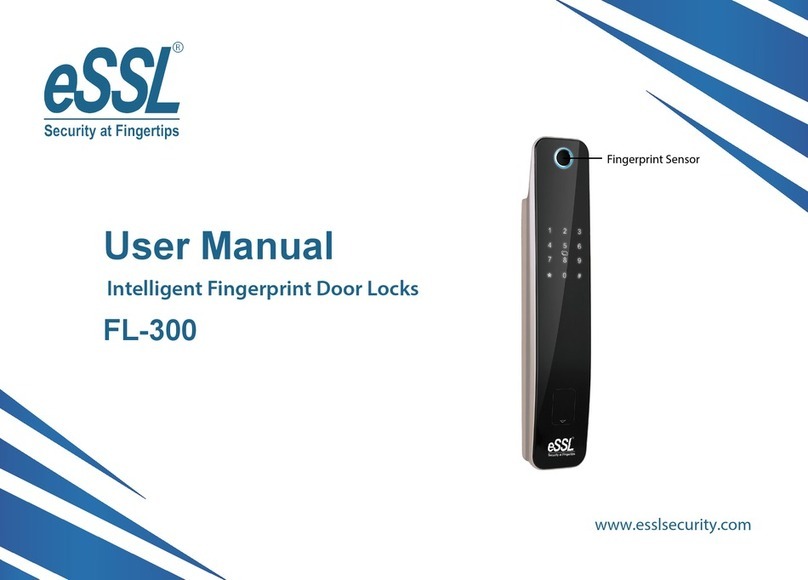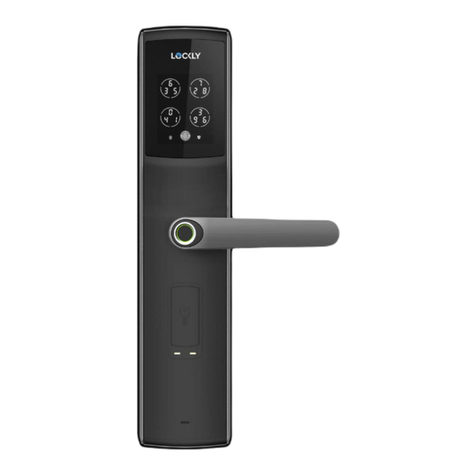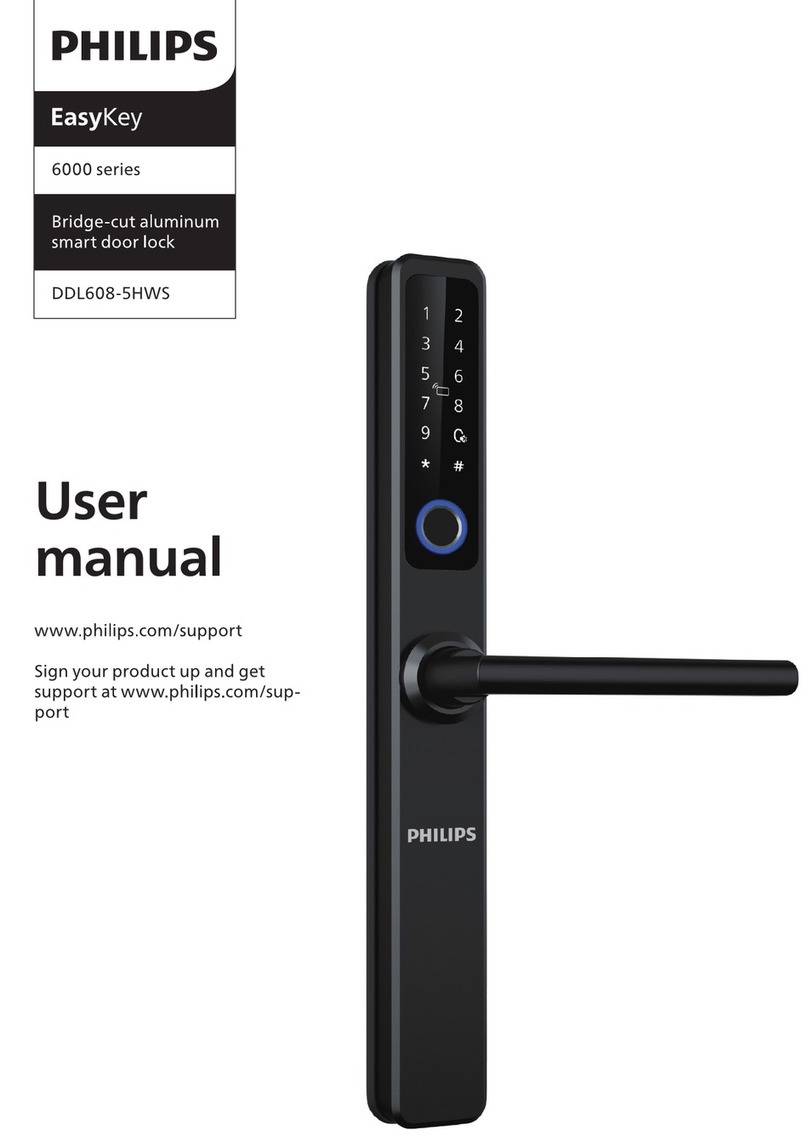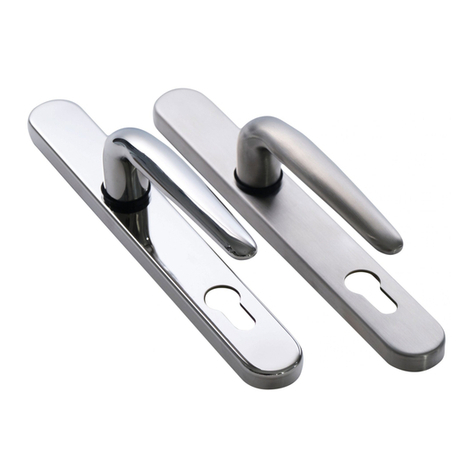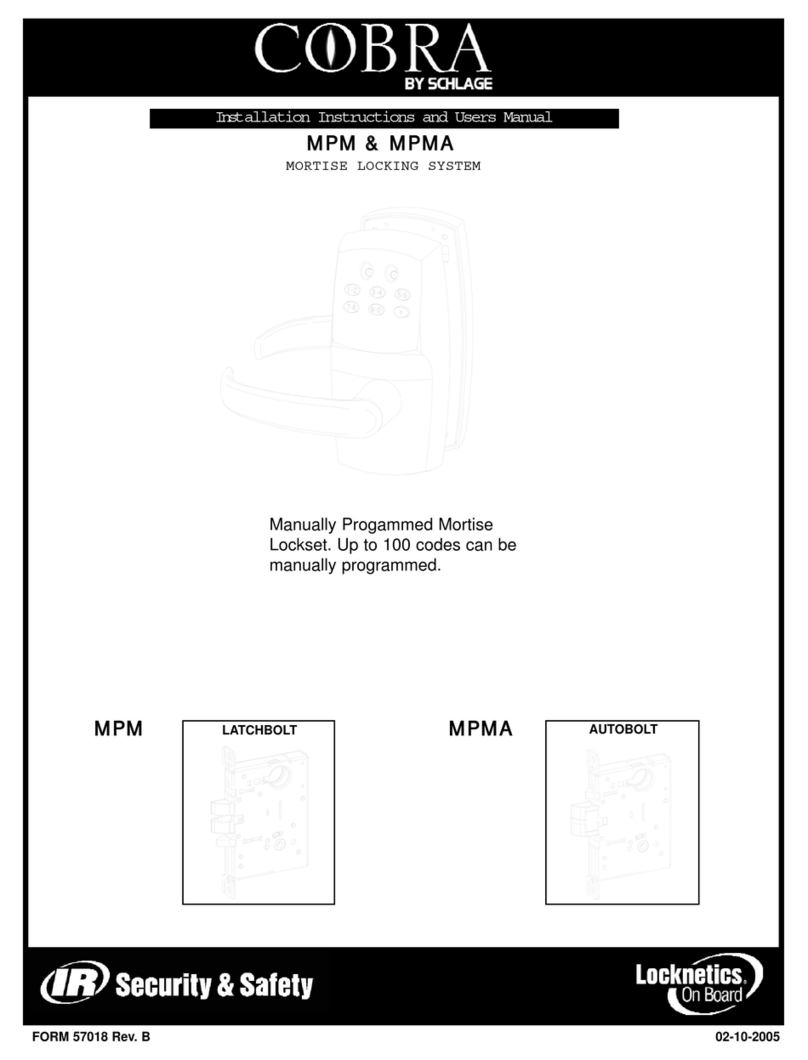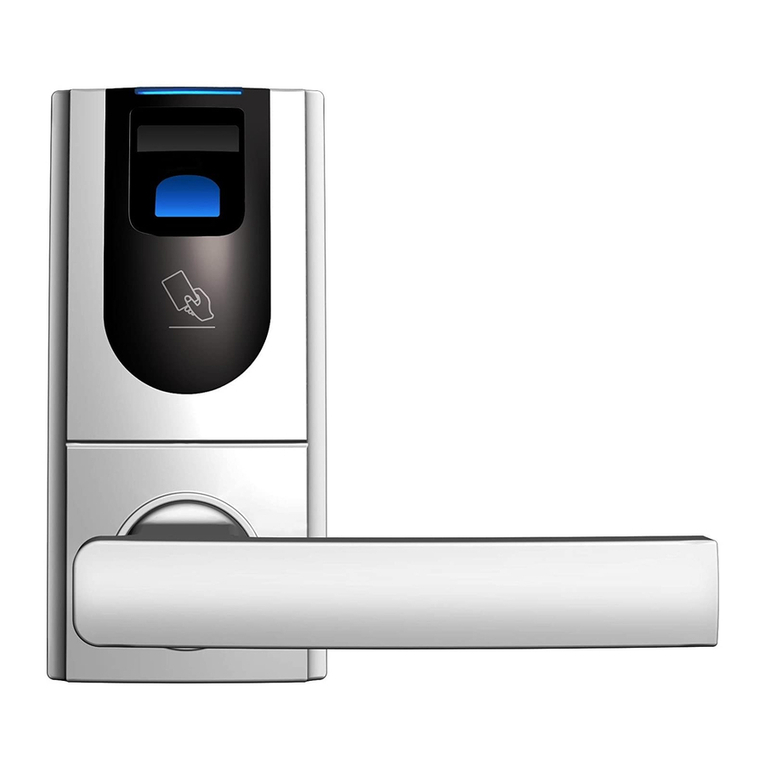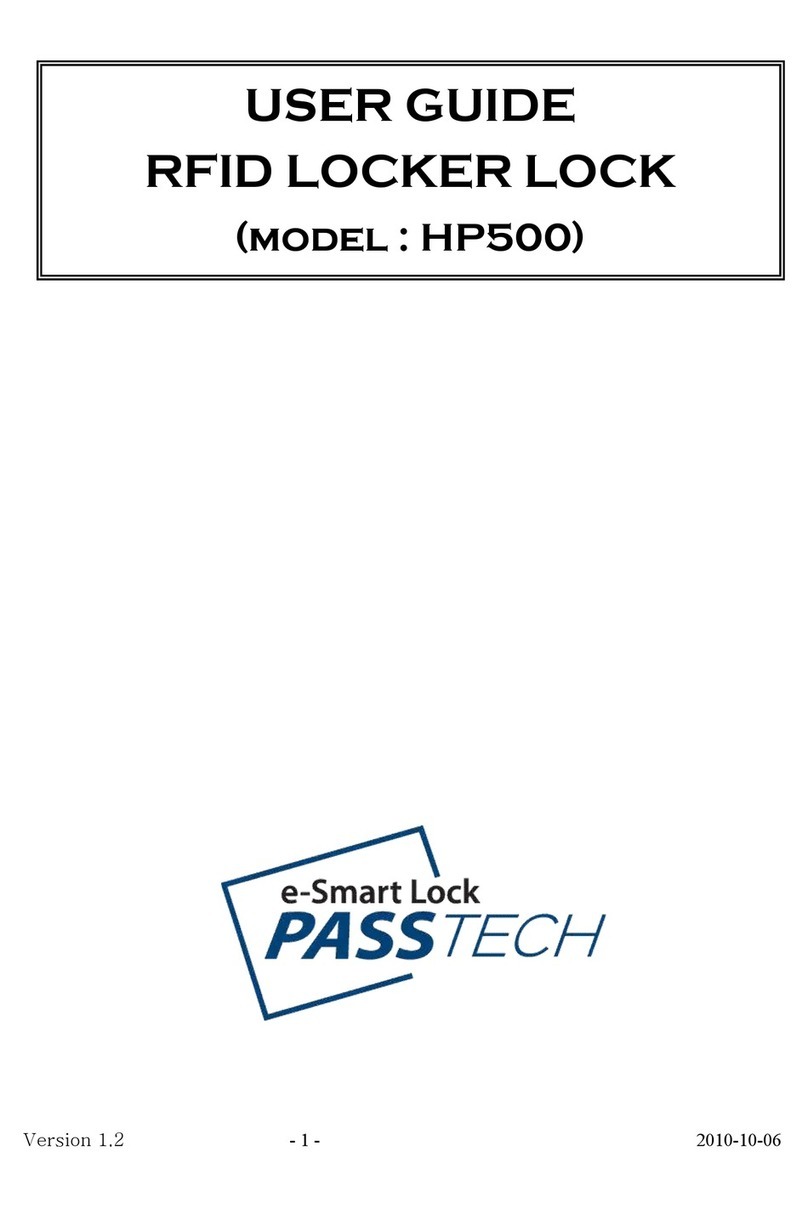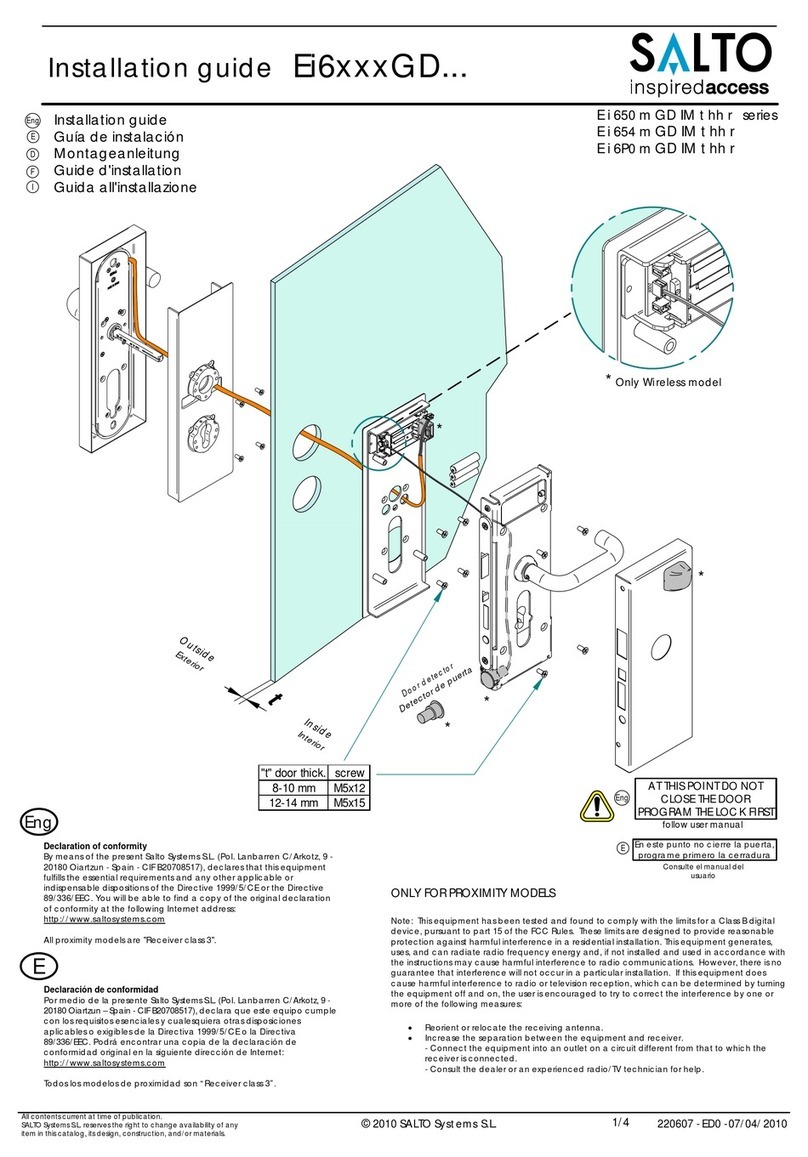Techno CNC Systems Patriot Operating instructions

TechnoCNC Patriot
Door Lock Troubleshooting
Applies to Control Interface version 1.421 and above.
Version 4
April 2011

Table of Contents
Introduction
Symptoms
Explanation of Tools
Software Requirements
Diagnostics
Tools
Diagnosing Steps
1. Setup Procedure
2. Lock Mounting Procedure
3. heck Sensor Misalignment or Damage
Damaged Sensor
Misaligned Sensor
Behavioral Issues
Door Latch Re-Engages Too Quick
Spindle Doesn't Turn On
Door Locked Always On
Introduction
The Patriot door locking mechanism as designed to prevent unsafe machine operation. When set up
correctly, pressing the “Door” button on the interface ill unlatch the door, but it on't open
automatically. You have to first release the latch, by pressing do n on the door handle. You should hear
the latch click a ay, and the door ill open by lifting on the handle. When you first get your machine,
the gas springs may be a bit stiff; after some use, they should loosen up and allo the door to open
smoothly.
The teachers' key gives an administrator the ability to override the door latch safeties or force the door
open. When the door safety is overridden, the spindle ill operate even if the door is open.
To set up your interlocking mechanism for the first time, follo the first step in Diagnosing Steps.
Symptoms
When setting up the interlock, you may get an INT-1 or INT-2 or INT-3 error or an error message that
begins ith “Interlock not properly detected because...”, depending on the version of your soft are.
These errors refer to a sensor that isn't being detected during the setup process, and can be caused by a
misaligned or damaged sensor, improper setup procedures, or faulty assembly.

Explanation of Tools
Software Requirements
The first step is to make sure you have appropriate soft are. The TechnoCNC Control Interface that
this document references is version 1.421. Anything later than that (1.422) ill ork just fine. You can
do nload the latest version at technorouters.com (click on Control Interface in the menu to the left).
Diagnostics
The tool you'll use to help diagnose the problem can be found under Setup -> Diagnostics. The
Diagnostics screen sho s the status of the “door open” and “door locked” sensors under Ctrl Inputs.
Note that the lock is ired such that it is impossible to have the door locked sensor be active ithout
the door closed. In other ords, it's impossible for the door to be locked, but not also closed.
Secondly, hen the s itch is activated, the door closed and door locked boxes ill NOT be checked.
These s itches are flipped from normal input, so the absence of a red check box means the sensor has
been activated. See images belo for clarification.
Lastly, there is a check-box option under CtrlReg called “Override Door”. This ill force the lock open
or closed, regardless of the state of the interlock. Note that if you click on it, it ill arn you before
preceding. If you use the space bar to toggle the state of the check box after you've clicked once, it
on't prompt you.
Tools
You may need a 3 mm hex rench to remove the door lock assembly.
Illustration 1: On the left, the door is open and unlocked. On the right, the
door is closed and locked. Note that Override Door needs to be checked to
release the door latch and open the door.

Diagnosing Steps
While there are multiple causes of these errors, some causes are more common than others.
1 Setup Procedure
The procedure for detecting the interlock can be difficult to follo if you're in a rush. Be sure to read
all the prompts, and follo the instructions properly.
Go to Setup > Advanced > Hard are S itches and make sure Use Interlock is checked, and Auto
Relatch is checked. Click on the Detect Interlock button to set up the interlock.
2 Lock Mounting Procedure
Go to Diagnostics and un-check the Override Door checkbox. This ill force the lock to move for ard,
into the lock position. Push the door do n into the lock. Did the door properly push the lock aside, and
settle in to the closed position, or did the lock get in the ay?
If the door properly closed
The lock assembly is properly mounted. Go on to the next step.
If the lock got in the way
Loosen the four hex bolts that mount the lock in position, and slide the hole lock assembly to ard the
back of the machine. Tighten the bolts, making sure that the lock is as far back as it ill go. Repeat the
procedure above. If the lock still hits the bottom of the door and doesn't allo the door to close, take
note of ho far back the lock should be to allo the door to close properly. It's probably on the order of
a fe millimeters.
Unbolt the four hex bolts, and remove the lock assembly through the bottom of the machine. If you
have a stand, you can open the dra er to provide access. The lock assembly is connected via a hite
connector that you can disconnect if you need more room.
When you have the lock assembly out of the machine, take note of the small scre in the front. The
more you tighten it, the further back the lock sits hen it's in the locked position. For the door to close
properly, the scre should be tightened so that the lock moves back a fe millimeter or so. Move the
lock back to a position you believe is adequate.
Remount the lock assembly. Be sure to reconnect the assembly to the controller! Slide the assembly as
far to ard the back of the machine as the four bolts ill allo , and tighten them. When the lock is
Illustration 2: Interlock Setup. Note that the text on
the right ay be cut off, depending on the version of
the software you use.

properly seated, you should be able to close the door easily, even if the lock is in the locked position.
The door ill simply push the lock out of the ay as it closes.
Try the interlock setup again. While the procedures above may not fix the problem, it's critical that the
lock assembly be properly mounted because sensor adjustment relies on it.
3 Check Sensor Misalignment or Damage
The door closed sensor is a black tubular scre , that pokes up a bit above the surface of the lock
assembly. There is a magnet mounted in the bottom of the door that activates the door sensor. T o
things can go rong here: either the sensor is damaged, or the sensor is simply misaligned.
Damaged Sensor
If the sensor is damaged, you may find scrapes and gashes in the top of the sensor, here it as
knocked. A damaged sensor ill exhibit strange behavior. In Diagnostics, you may find the door closed
signal activated even hen the door isn't closed. But then magically become deactivated for no
apparent reason. Lightly flicking the top of the sensor ith a finger can cause a damaged sensor to
s itch states. If you find this behavior, call Techno to get a replacement.
Misaligned Sensor
Because the door sensor is triggered by a magnet, all magnets in the area can potentially trigger the
sensor. There are t o other magnets; one inside the locking latch itself, and another in the solenoid that
moves the lock into position. When the lock is in the for ard position, the magnet in the latch can
influence the door closed sensor. This on't be a problem if a) the magnet in the door is strong and
properly mounted, and b) if the door closed sensor is mounted high enough to be above the influence of
the lock magnet. Note that it can also be triggered because the lock moves for ard too far, but if you've
follo ed the steps in Section 2, this on't be a problem.
To align the door closed sensor, open the Diagnostics screen so you can see the status of door closed
and door locked sensors. Open the door, and check Override Door such that the latch is in the locked
position (for ard). Reach under the door lock assembly, and find the black plastic nut that holds the
door closed sensor in place. Unscre this nut, and back the sensor out until the top of the sensor sits at
the surface of the case floor. You ill probably see both door closed and door locked sensors triggered.
This is because the door closed sensor is being activated by the door locked magnet. Slo ly scre the
sensor until it starts moving up. At some point (perhaps a quarter inch above the floor), both door
closed and door locked signals ill turn off. This means that the door closed sensor is no positioned
high enough to be out of the influence of the latch magnet. Scre the sensor up a tiny bit extra (just to
be safe), and lock it into position using the black plastic nut.
No close the door so that it is latched, but you aren't pushing on it. Verify that both the door closed
and door latched signals indicate the door is closed and latched. If the door closed signal isn't being
activated, keep the door closed hile you scre the sensor up. Bring it up until it is activated (and then
an extra bit just to be safe). Tighten the black nut to hold the sensor in place.
Press the door do n and verify the sensor signals do not change. If they do change, you may need to
prevent the door latch from moving too far for ard. Tighten the scre that pushes back on the door
latch, but not so far that the latch can't grab the door or activate the door locked sensor.
There's a good chance you've fixed your problem no . Rerun the Detect Interlock setup. If it fails ith

an error, there are a fe more possibilities that need checking. If it passes, verify the Door button on
the front interface properly disables the latch, and that pushing do n on the door releases the latch and
allo s the door to open. If you have Auto Relatch enabled, pushing the door closed ill automatically
engage the door latch.
Behavioral Issues
Door Latch Re-Engages Too Quick
If the latch releases, but then re-engages too quickly for the door to be released (you'll hear it clicking
back and forth), the door closed sensor is disengaging hen you push the door do n, and then re-
engaging hen it moves back up, causing the soft are to believe the door as pushed closed. Raise the
door closed sensor ith the door in the fully locked and closed position, until the door closed signal is
triggered. Push do n on the door, and verify that the door closed signal does not go out.
There is a perfect area bet een the latch magnet triggering the door closed sensor (door closed sensor
too lo ), and the door magnet passing by the door closed sensor (door closed sensor too high). This is
the area here the door closed sensor should be mounted. When it's properly aligned, the door closed
signal ill be triggered hen the door is closed, and hen the door is pushed do n to release the lock.
Spindle Doesn't Turn On
The spindle has been ired to operate only under safe conditions. If the interlock key is set in the
Normal position, but the spindle doesn't turn on even hen the door is closed and locked, the door
closed sensor is likely not being seen. This is caused by the door closed sensor mounted too lo for the
magnet to trigger the sensor hile it's hooked to the door latch. Moving the door closed sensor higher
ill fix this.
Door Locked Always On
If the door locked sensor is al ays on, regardless of the door and lock position, the lock assembly may
have a diode installed incorrectly. This is a rare problem, but it's conceivable. The easiest thing to do in
this case is have the entire lock assembly replaced.
I Can't Get It To ork!
The Patriots have gone through a fe revisions since their introduction, and a fe revisions to the door
latch and magnet assembly ere performed to make it easier to install. While all versions have been
tested to ensure they ork properly, shipping may cause misalignment or damage. As the machine is
used, components can ear do n, be misaligned or damaged. If you can't get the door to properly
latch, or to properly detect the interlock, you may have damaged sensors, magnets, or even cable
assemblies under then machine. In all these cases, it's best to call Techno for help. We'll help guide you
through these instructions, and ill be able to further diagnose damaged equipment.
Before you call, please double-check to make sure nothing is obstructing a sensor or other component,
and that no component appears damaged.
Table of contents
Popular Door Lock manuals by other brands

Dorma
Dorma SVP 22 DCW Series Mounting instructions

Gainsborough
Gainsborough SD8 ILLUSTRATED FITTING INSTRUCTIONS
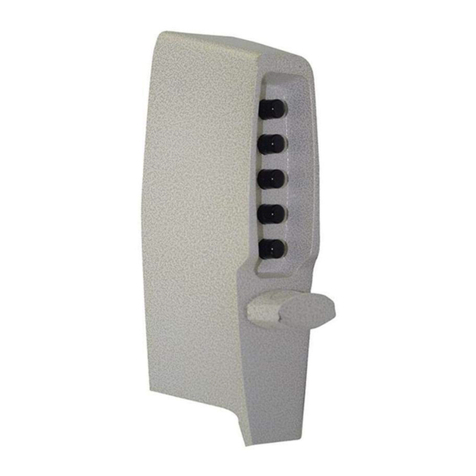
Kaba
Kaba Simplex 7104 Series installation instructions

Ingersoll-Rand
Ingersoll-Rand Schlage BE365 user guide
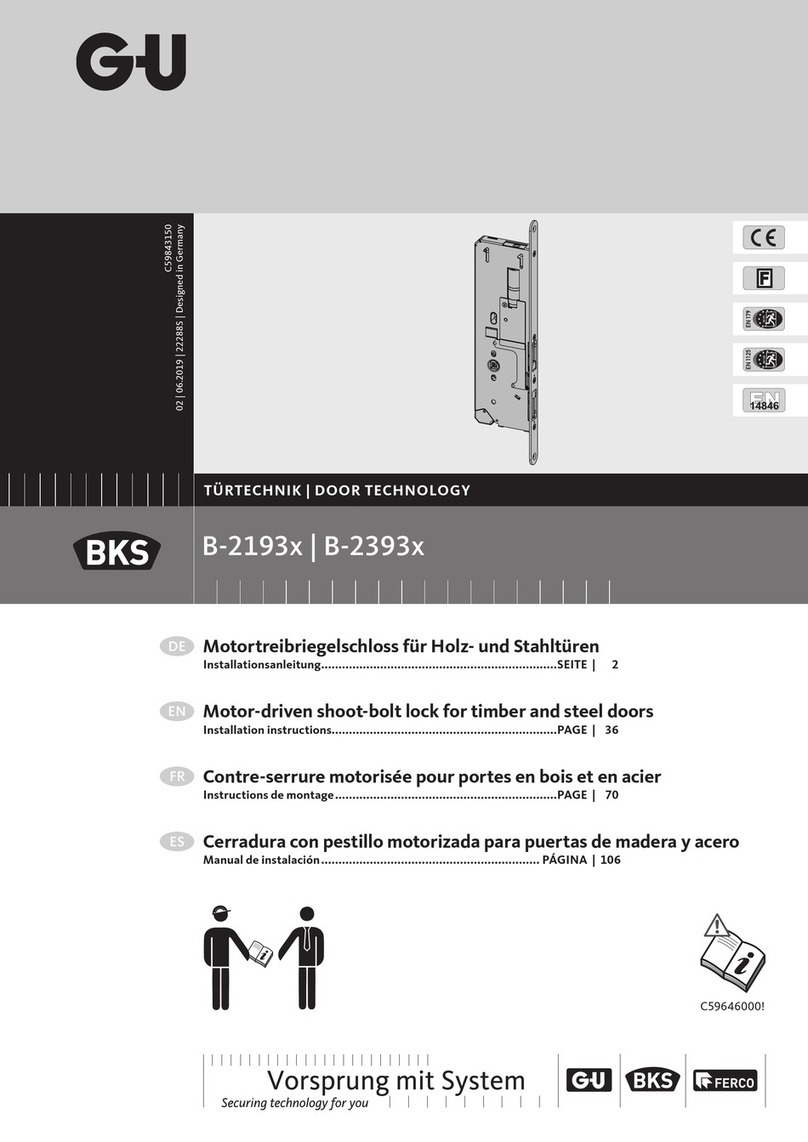
G-U
G-U BKS B-2193 Series installation instructions

Simplex
Simplex 3000 Series Assembly instructions
